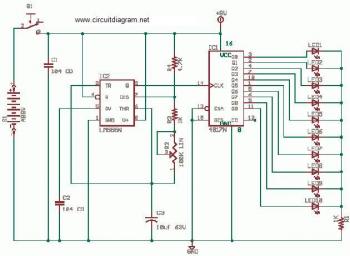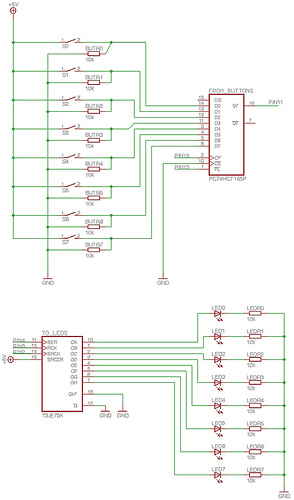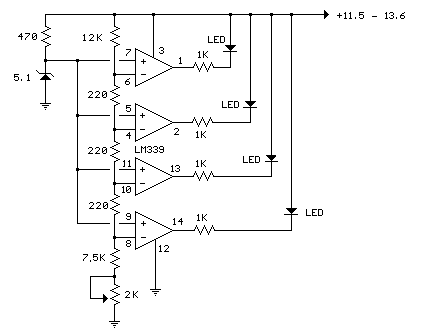
Running LEDs

This is a doorbell circuit featuring flashing LEDs for enhanced visual appeal. The NE555 integrated circuit (IC1) functions as a clock generator, configured as an astable multivibrator with a frequency adjustable via a potentiometer (VR1). The clock pulses generated by IC1 are directed to a sound generator that simulates the sound of a British police car siren. The circuit incorporates two timer IC 555s to produce sound frequencies. The right-side 555 timer acts as the alarm sound generator, while the left-side 555 timer operates at a frequency of 1 Hz. The circuit can be powered from a household electrical line by integrating a non-polar capacitor and a 1 kΩ/1W metal oxide resistor to facilitate LED activation in series. It is important to modify the capacitor value from 0.47 µF/250V to 0.22 µF/400V for compatibility with 240VAC power. Additionally, this circuit serves as a temperature output indicator, utilizing two LEDs (D1 and D2) to signify temperatures above and below 80 degrees Celsius. The LM35 integrated circuit is selected as the temperature sensor for this application. The circuit diagram includes a clock generator based on NAND gate logic ICs, with options to use either the 7400 (TTL type) or the 4011 (CMOS type). The 4011 is more cost-effective, while the 7400 offers faster performance.
The doorbell circuit is designed to provide both auditory and visual alerts, enhancing its functionality. The NE555 timer, configured as an astable multivibrator, generates a square wave output that can be adjusted in frequency using the potentiometer VR1. This frequency modulation allows for customization of the flashing LED rate, making the doorbell more engaging.
The sound generation aspect of the circuit utilizes two NE555 timers. The first timer is dedicated to producing a siren-like sound, simulating the auditory experience of a British police car. The second timer is set to a 1 Hz frequency, which can be used for additional alert sounds or chimes.
To incorporate the doorbell circuit into a home electrical system, a non-polar capacitor and a 1 kΩ/1W metal oxide resistor are needed. These components enable the circuit to draw power from the household AC line while ensuring safe operation of the LEDs. The specified capacitor values are crucial for proper functioning, particularly when adapting the circuit for 240VAC applications.
The temperature sensing feature of the circuit is enabled by the LM35 IC, which provides an analog output voltage proportional to the temperature. The two LEDs (D1 and D2) serve as visual indicators, illuminating to signal when the temperature exceeds or falls below the specified threshold of 80 degrees Celsius. This feature can be particularly useful in environments where temperature monitoring is essential.
The clock generator circuit, based on NAND gate logic, offers flexibility in design. The choice between the 7400 and 4011 ICs allows designers to balance cost and performance based on their specific needs. The 7400 series provides faster switching times, while the 4011 series is often favored for its lower cost in applications where speed is less critical. Overall, this doorbell circuit combines visual and auditory signals with temperature monitoring capabilities, making it a versatile addition to any home automation system.This is the door bell circuit with flashing LEDs to make the circuit more attractive. IC1 (NE555) is applied right here as being a clock generator. It is actually set up as an astable multivibrator whose frequency could be altered using the support of potensiometer VR1. The clock pulses received from IC1 are fed to. This is the sound generator wh ich will simulate British police car siren. The circuit is built using 2 pieces of timer IC 555 to generate sound frequency. How the circuit work: The 555 on the right is wired as an alarm sound generator and the second 555 timer on the left is a 1 Hz. You can easily activate the LED from home electrical power line with this circuit diagram. You just need to add a nonpolar capacitor and a 1Kohm / 1W metal oxide resistor to activate the LEDs from home power line with serial connection.
Note: Change the capacitor value from 0. 47uf/250V to become 0. 22uF/400V for 240VAC power. This circuit is a circuit which will provide output indicator of the temperature around the circuit. The indicator is just 2 pieces LEDs (D1 and D2) which indicates the heat of above 80 degrees Celsius and below 80 degrees Celsius. A well-known IC LM35 is chosen to be the temperature sensor in this circuit. Output. The following diagram is the Clock Generator circuit diagram which build based on NAND Gate logic IC.
You may use IC 7400 or 4011 for this circuit. The 7400 is a TTL type, while 4011 is CMOS type. IC 4011 is cheaper than 7400 but the 7400 is faster than 4011. Circuit Notes: Excellent clock. 🔗 External reference
The doorbell circuit is designed to provide both auditory and visual alerts, enhancing its functionality. The NE555 timer, configured as an astable multivibrator, generates a square wave output that can be adjusted in frequency using the potentiometer VR1. This frequency modulation allows for customization of the flashing LED rate, making the doorbell more engaging.
The sound generation aspect of the circuit utilizes two NE555 timers. The first timer is dedicated to producing a siren-like sound, simulating the auditory experience of a British police car. The second timer is set to a 1 Hz frequency, which can be used for additional alert sounds or chimes.
To incorporate the doorbell circuit into a home electrical system, a non-polar capacitor and a 1 kΩ/1W metal oxide resistor are needed. These components enable the circuit to draw power from the household AC line while ensuring safe operation of the LEDs. The specified capacitor values are crucial for proper functioning, particularly when adapting the circuit for 240VAC applications.
The temperature sensing feature of the circuit is enabled by the LM35 IC, which provides an analog output voltage proportional to the temperature. The two LEDs (D1 and D2) serve as visual indicators, illuminating to signal when the temperature exceeds or falls below the specified threshold of 80 degrees Celsius. This feature can be particularly useful in environments where temperature monitoring is essential.
The clock generator circuit, based on NAND gate logic, offers flexibility in design. The choice between the 7400 and 4011 ICs allows designers to balance cost and performance based on their specific needs. The 7400 series provides faster switching times, while the 4011 series is often favored for its lower cost in applications where speed is less critical. Overall, this doorbell circuit combines visual and auditory signals with temperature monitoring capabilities, making it a versatile addition to any home automation system.This is the door bell circuit with flashing LEDs to make the circuit more attractive. IC1 (NE555) is applied right here as being a clock generator. It is actually set up as an astable multivibrator whose frequency could be altered using the support of potensiometer VR1. The clock pulses received from IC1 are fed to. This is the sound generator wh ich will simulate British police car siren. The circuit is built using 2 pieces of timer IC 555 to generate sound frequency. How the circuit work: The 555 on the right is wired as an alarm sound generator and the second 555 timer on the left is a 1 Hz. You can easily activate the LED from home electrical power line with this circuit diagram. You just need to add a nonpolar capacitor and a 1Kohm / 1W metal oxide resistor to activate the LEDs from home power line with serial connection.
Note: Change the capacitor value from 0. 47uf/250V to become 0. 22uF/400V for 240VAC power. This circuit is a circuit which will provide output indicator of the temperature around the circuit. The indicator is just 2 pieces LEDs (D1 and D2) which indicates the heat of above 80 degrees Celsius and below 80 degrees Celsius. A well-known IC LM35 is chosen to be the temperature sensor in this circuit. Output. The following diagram is the Clock Generator circuit diagram which build based on NAND Gate logic IC.
You may use IC 7400 or 4011 for this circuit. The 7400 is a TTL type, while 4011 is CMOS type. IC 4011 is cheaper than 7400 but the 7400 is faster than 4011. Circuit Notes: Excellent clock. 🔗 External reference





